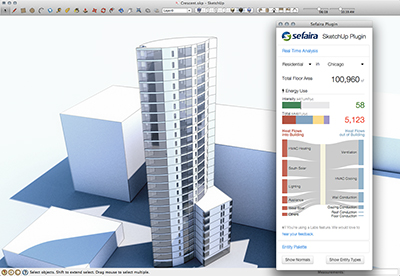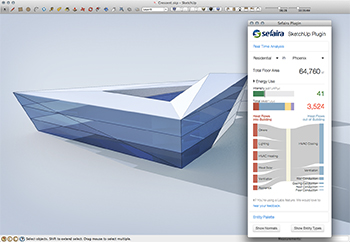Sefaira Announces New Energy Analysis Software
 LONDON — In continuing to provide innovative software to develop high-performance buildings, Sefaira today announced the Sefaira for SketchUp plugin, the first real-time energy analysis software for building design.
LONDON — In continuing to provide innovative software to develop high-performance buildings, Sefaira today announced the Sefaira for SketchUp plugin, the first real-time energy analysis software for building design.
Sefaira for SketchUp provides an energy analysis of a building in order for architects to consistently design energy-efficient buildings without leaving the design environment. The software helps architects connect their design decisions to the energy performance of the building.
“The turnaround time for this kind of analysis used to be days if not weeks and now it can happen in seconds,” said Carl Sterner, senior product manager at Sefaira.
The concept for Sefaira began in 2009 when co-founders Mads Jensen and Peter Krebs realized that architects did not have the appropriate tools they needed to consistently create high-performance buildings. After three years of development, Sefaira launched in summer 2012.
“Essentially what we do for designers is recognize that the building design is often times a complex process that can span months or years and a process throughout which thousands of decisions are made that impact the building’s performance,” Jensen said.
The founders met with more than 100 architects to identify why they were not seeking to produce high-performance buildings. A major challenge for architects was that there was no analysis concerning the implications of their design decisions, Jensen said. The cloud-base analysis engine allows designers to see errors before it’s too costly or too late to revisit the design.
“It’s not until very late in the design process that the project might get a team of consultants or engineers to do a proper energy analysis,” Jensen said. “By then, you often end up with a design that’s less than optimal and you don’t get the energy performance you’re looking for, in which case you might have to redesign the building or invest in expensive systems or technologies to try and make up for that shortfall.”
 Now, more than 200 leading design firms are using Sefaira, Jensen said. The introduction of the SketchUp plugin brings an increased focused on energy analysis. A color-coded display demonstrates how much energy is being used in the heating, cooling, lighting and appliances of the building. The tool, which provides constant feedback, also identifies the design elements that are most responsible for poor energy performance. An architect can see in real-time where energy is coming and where it is going in the designed building.
Now, more than 200 leading design firms are using Sefaira, Jensen said. The introduction of the SketchUp plugin brings an increased focused on energy analysis. A color-coded display demonstrates how much energy is being used in the heating, cooling, lighting and appliances of the building. The tool, which provides constant feedback, also identifies the design elements that are most responsible for poor energy performance. An architect can see in real-time where energy is coming and where it is going in the designed building.
“What we’re doing now is introducing a plug-in that sits directly inside of SketchUp, which many designers use for early stage design, that allows them to perform real-time analysis directly inside that environment,” Jensen said. “As they change the building design, they’ll be able to immediately see the impact on energy consumption on those design changes. It’s a very intuitive design, it’s very easy to use and it’s very immersive.”
It’s important to view a building as an integrated system in which everything impacts everything else, Jensen said. Sefaira for SketchUp also automatically interprets glazing, walls, roofs, floors, shading and the way design features increase or decrease energy efficiency.
The software is so easy to use, Sterner said, that the designer doesn’t have to do much to see the impact of their design since the software updates automatically. This is also highly beneficial because it doesn’t interrupt an architect’s workflow, Sterner said.
“In the early stages, if design architects are often moving incredibly quickly and making a lot of decisions about the shape of the building and the amount of glass and shading, they just don’t have time to stop what they’re doing, go to a different environment for analysis and then go back. So we’re bringing the analysis to them,” Sterner said.
Architects can immediately see the impact of the design and make positive design decisions in the planning stages rather than being reactionary later in the process.
“The architect can just concentrate on doing what they do best, which is design,” Sterner said.
